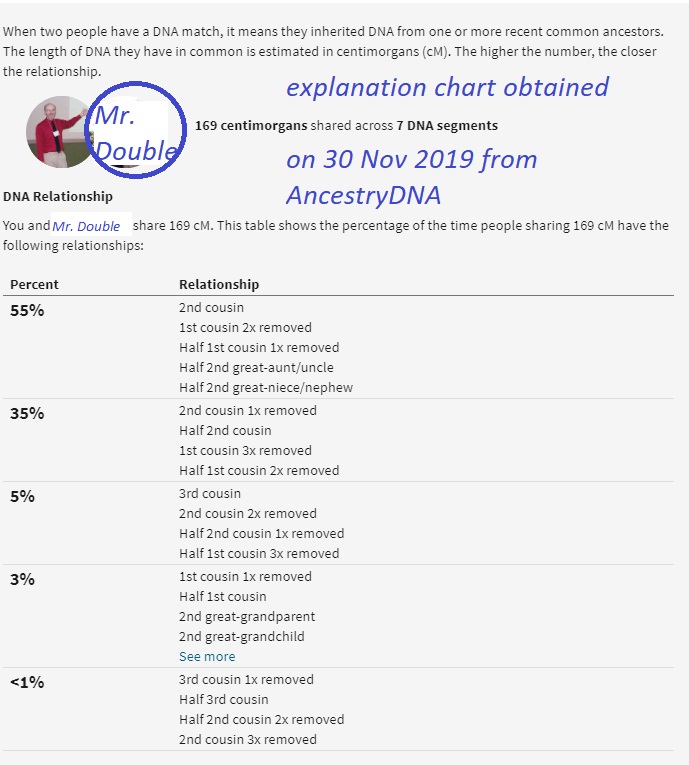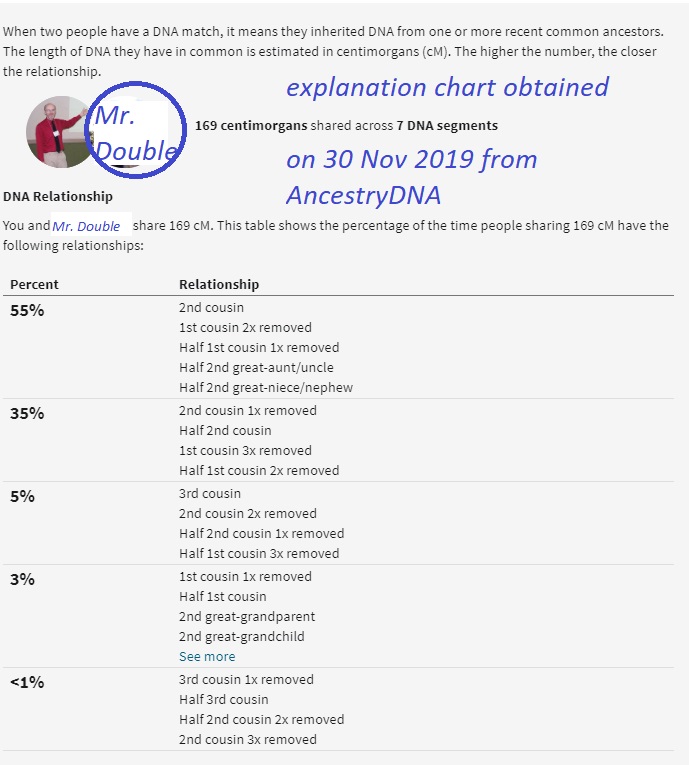I’ve have quite a few double and triple cousins. Some of them are not all that far back in my family tree. For many, I can see the double or triple relationships via shared ancestor names by the time I’m back to my second or third great-grandparents. I’ve always hoping that more of them would have a DNA test done just to see how really “close” we were in terms of a genetic relationship and how much DNA we shared. I realize that any information I obtain from these individuals will be anecdotal.
One of my double relatives finally appeared on my list of DNA matches. We will call Mr. Double. Our grandfathers were double first cousins. For privacy reasons, I’m not revealing his name, but one of my sets of great-grandparents were Charlie (1875-1948) and Fannie (1883-1965) (Rampley) Neill of St. Albans Township, Hancock County, Illinois. My cousin’s great-grandparents were Fannie’s brother Louis Rampley and Louis’ wife Mary Neill (sister of Charlie Neill).
As a result, Mr. Double and I are double third cousins. We both have our trees on AncestryDNA and have those trees linked to our DNA test results. We share 169 cM of DNA according to my test results at AncestryDNA. AncestryDNA predicts that we are 3rd to 4th cousins.
AncestryDNA also includes a chart outlining the percentage of times individuals sharing 169 cM of DNA have various relationships based on their paper genealogies. Two interesting things about this chart from AncestryDNA:
- it indicates that 90% of the time the relationship is closer than 3rd cousin when 169 cM are shared.
- it’s the same chart of percentages I obtained when looking at a DNA match (on another family where I share 163 cM of DNA). It would seem that the percentages should be slightly different. Unless the percentages shown are for ranges of shared DNA and not one specific value.

Interestingly the cousin with whom I share 163 cM of DNA is actually my second cousin (our grandparents are siblings). The 163 cM cousin is on my maternal side and Mr. Double is on my paternal side.
Another interesting note about Mr. Double. In both cases our double relationship to each other is filtered through one grandparent. I don’t have too many double or triple relationships this close that come down to me through different grandparents.
The take away here? We will avoid getting too mathematical and remind readers that the relationship estimators get less precise the further back one gets. There is also a good chance that I do not have exactly 1/8th of my DNA from each of my great-grandparents and there is an even greater chance that I do not have exactly 1/16th of my DNA from each of my great-great-grandparents.
Blame your ancestors. Blame probability. Blame genetics. But remember that relationships are estimates and that paper records need to augment your DNA matches.
Based on the shared DNA between these two people and me, one might be tempted to think they are related in the same way to me. They are not.
There’s an interesting additional comment to make here–although it is anecdotal–repeat: anecdotal. Both of these matches and I share four great-great-grandparents.
Mr. Double and I have four great-great-grandparents who are the same (Samuel/Annie Neill and Riley/Nancy Rampley). The 163 cM match and I also share four great-great-grandparents (Jann/Anke Habben and Foche/Anna Goldenstein). But it’s not the same for me and these two matches. There’s a difference in how the DNA was passed down though from these sets of ancestors to the matches and to me. In the Neill/Rampley case, Mr. Double and I descend from different children of both these sets of great-great-grandparents. In the 163 cM match case we both descend from the same Habben child and Goldenstein child. The 163 match and I have one less generation to “unshare” DNA.
It may be just the luck of the DNA draw that Mr. Double and I share as much DNA as we do. One should not expect “double relationship” to double the amount of shared DNA.
That’s not how it works.


No responses yet